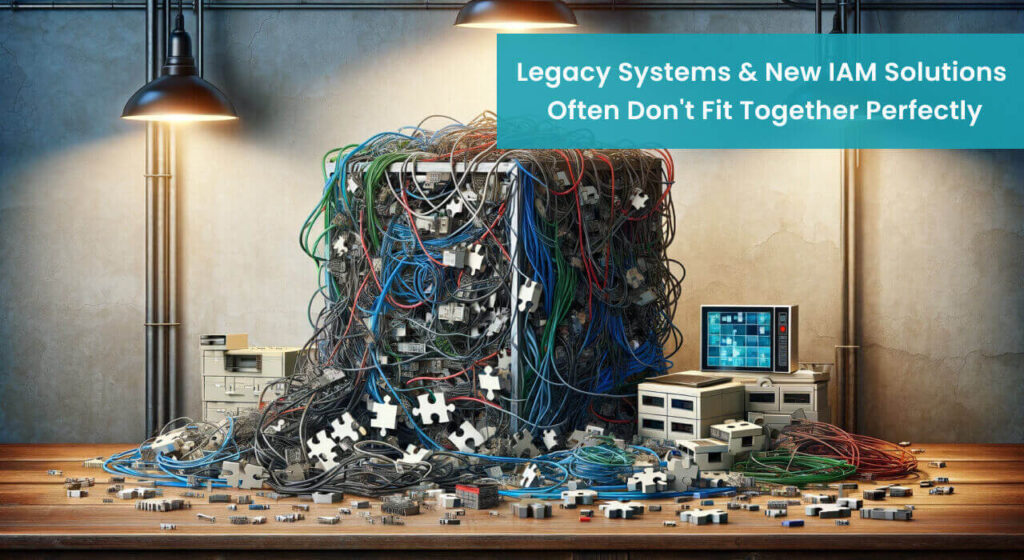
In today’s digitally interconnected world, organisations entrust a vast amount of sensitive data and resources to their employees, partners, and customers. This necessitates robust access control mechanisms to safeguard these assets from unauthorised access, data breaches, and other security threats. Identity and Access Management (IAM) has emerged as a critical cornerstone of modern cybersecurity strategies, playing a pivotal role in ensuring the right individuals have the appropriate access to the right resources, at the right time.
A recent study by IBM found that the average cost of a data breach in Australia reached a staggering $4.14 million in 2023, highlighting the significant financial repercussions of inadequate access control. IAM solutions act as the gatekeepers, meticulously verifying user identities and meticulously assigning granular access privileges, effectively mitigating the risk of unauthorised access and subsequent data breaches.
However, the growing complexity of security landscapes, often comprised of diverse technologies and solutions, presents a significant challenge. Integrating new IAM systems seamlessly into existing security stacks can be a complex and time-consuming process, potentially hindering the overall effectiveness and efficiency of the security posture. This article delves into the crucial yet often overlooked aspect of integrating IAM with existing security stacks within the Australian context. We explore the unique considerations for Australian organisations and showcase how Packetlabs, a leading provider of IAM solutions, empowers seamless integration, fostering a robust and unified security environment.
The Australian Context

Australian organisations navigating the ever-evolving digital landscape face a unique set of considerations when implementing IAM solutions. Stringent regulations, such as the Australian Privacy Principles (APPs) enshrined in the Privacy Act 1988, mandate robust data protection and accountability for personal information held by organisations. These principles necessitate granular control over access to personal data, making a comprehensive and compliant IAM system paramount.
Furthermore, the Australian Cyber Security Centre (ACSC) consistently reports a rise in cyber security threats targeting Australian businesses and institutions. These threats encompass malicious attacks such as phishing scams, ransomware, and data breaches. Implementing robust IAM solutions empowers organisations to mitigate these risks by strengthening access controls, safeguarding sensitive data, and fostering a more secure digital environment.
Therefore, Australian organisations must carefully evaluate IAM solutions that not only offer seamless integration with existing systems but also demonstrably adhere to the nation’s stringent data protection regulations and effectively address the evolving cyber security threat landscape.
The Challenge: Integrating IAM with Existing Systems

The quest for enhanced security through IAM implementation can be hindered by the inherent complexities associated with integrating new solutions into existing security infrastructures. Organisations often encounter a myriad of challenges that can impede a smooth and successful integration process.
One of the most common hurdles lies in incompatibility between the proposed IAM solution and existing security systems. Legacy systems, built with older technologies and standards, may not readily interface with newer IAM solutions, necessitating costly and time-consuming customisations or workarounds. This incompatibility can introduce vulnerabilities and create security gaps, jeopardizing the overall effectiveness of the security posture.
Furthermore, configuring IAM systems often involves intricate and daunting processes, requiring specialised technical expertise. Organisations may face difficulties navigating complex configuration options and integrating with diverse authentication protocols, potentially leading to delays and errors in deployment. This complexity can also strain internal IT resources, diverting them from core business functions and hampering their ability to manage the new IAM solution effectively.
Another significant challenge arises from the siloed nature of data management within various security systems. Disparate data repositories across different applications and platforms can hinder the IAM system’s ability to gain a holistic view of user identities and access privileges. This fragmented data landscape creates significant challenges in enforcing consistent access control policies and maintaining accurate user information, potentially leading to security risks and compliance concerns.
The cumulative impact of these challenges can be detrimental for organisations. Integration complexities can lead to increased security risks, as vulnerabilities introduced during the process create potential entry points for cyberattacks. Operational inefficiencies stemming from cumbersome configuration and siloed data management can hinder productivity and escalate IT support costs. Additionally, a poorly integrated IAM solution can create a fragmented user experience, requiring users to navigate multiple logins and access control mechanisms, potentially reducing user adoption and hindering overall system effectiveness.
Packetlabs: Enabling Seamless Integration

Packetlabs, a leading provider of Identity and Access Management (IAM) solutions, empowers Australian organisations to navigate the complexities of IAM integration with a commitment to seamless interoperability and compatibility. Recognising the unique challenges faced by Australian organisations, Packetlabs offers a comprehensive suite of features specifically designed to ensure a smooth and efficient integration process within existing security landscapes.
One of Packetlabs’ core strengths lies in its extensive library of pre-built connectors and integrations specifically designed for popular Australian security solutions. These pre-built integrations eliminate the need for complex customisations and significantly reduce the time and resources required to integrate Packetlabs with existing systems. Additionally, Packetlabs embraces open-source standards and APIs, allowing for effortless integration with custom-developed applications and niche security systems within an organisation’s environment. This flexibility empowers organisations to leverage their existing investments in security technologies without facing compatibility roadblocks.
Furthermore, Packetlabs understands the diverse infrastructure realities faced by Australian organisations. They offer a variety of flexible deployment options, including cloud-based and on-premise solutions. This caters to the specific needs and security preferences of each organisation, ensuring seamless integration irrespective of the existing infrastructure configuration.
By prioritising interoperability and offering diverse integration options, Packetlabs empowers Australian organisations to overcome the challenges associated with integrating IAM solutions. This ensures a smooth and efficient integration process, ultimately fostering a robust and unified security environment.
Demonstrating Seamless Integration: A Case Study

Greenbuild Constructions, a prominent Australian home builder, previously struggled with managing user access across their complex security landscape. Their environment encompassed a mix of legacy on-premise systems and cloud-based collaboration tools, lacking a centralized IAM solution. This fragmented approach resulted in security vulnerabilities, compliance concerns, and a cumbersome user experience for their employees, contractors, and suppliers.
Packetlabs addressed Greenbuild Constructions’ specific needs by leveraging its commitment to seamless integration. Pre-built connectors facilitated a smooth connection with Greenbuild’s existing Active Directory and cloud-based project management platforms. Additionally, Packetlabs’ open-source APIs enabled integration with their custom-developed construction management system. This comprehensive approach eliminated the need for extensive customizations, minimizing implementation time and resource requirements.
The successful integration of Packetlabs resulted in a demonstrably improved security posture for Greenbuild Constructions. Granular access controls and automated user provisioning processes significantly reduced the risk of unauthorized access and streamlined compliance efforts. Furthermore, the centralized management of user identities through Packetlabs enhanced operational efficiency, freeing up IT resources previously dedicated to manual access management tasks. Finally, a unified user experience with single sign-on capabilities across various applications improved collaboration and communication amongst employees, contractors, and suppliers.
Greenbuild Constructions’ successful case study exemplifies the transformative potential of Packetlabs’ seamless integration capabilities. By addressing the unique challenges faced by Australian organisations, Packetlabs empowers them to achieve a robust and unified security environment, fostering improved security, streamlined operations, and a superior user experience.
While this case study exemplifies the power of seamless integration, a comprehensive understanding of IAM is vital for Australian organisations. For a deeper dive into IAM functionalities and best practices for Australian businesses, explore this informative guide: From Confusion to Control: A Beginner’s Guide to IAM for Australian Businesses.
Benefits of Integration with Packetlabs

For Australian organisations navigating the complexities of the digital landscape, integrating Packetlabs with their existing security stacks unlocks a multitude of advantages, fostering a robust and secure environment.
Enhanced Security: Packetlabs empowers organisations to implement granular access controls, meticulously assigning permissions based on user roles and responsibilities. This meticulous approach significantly reduces the risk of unauthorized access to sensitive data and critical systems, bolstering the organisation’s overall security posture.
Streamlined Operations: Packetlabs centralizes user identity management, eliminating the need for disparate and time-consuming manual processes across various systems. This centralized approach simplifies compliance reporting and streamlines user provisioning and lifecycle management, freeing up valuable IT resources for other strategic tasks.
Improved User Experience: Packetlabs fosters a seamless user experience by enabling single sign-on capabilities. Users can access all authorized applications and resources with a single login, eliminating the need to manage multiple credentials and improving overall productivity. Additionally, role-based access control ensures users only have access to the information and functionalities they require, fostering a more secure and efficient work environment.
Cost-Effectiveness: Packetlabs‘ commitment to seamless integration minimizes the need for extensive customizations during implementation. This translates to reduced project timelines, lower resource requirements, and ultimately, cost-effectiveness for the organisation. Furthermore, the streamlined operations and improved user experience contribute to long-term cost savings through increased productivity and reduced support needs.
By integrating Packetlabs with their existing security stacks, Australian organisations gain a comprehensive solution that addresses the unique challenges of IAM implementation within the local context. Packetlabs empowers them to achieve a robust security posture, streamline operations, enhance user experience, and ultimately, achieve greater value from their existing security investments.
In today’s digitally interconnected world, robust Identity and Access Management (IAM) has become an indispensable cornerstone of effective cybersecurity for Australian organisations. However, integrating new IAM solutions with existing security stacks can be a complex and potentially disruptive process.
This article has explored the unique considerations and challenges faced by Australian organisations regarding IAM implementation. We have discussed the growing complexity of security landscapes, stringent data protection regulations, and the ever-evolving cyber security threat landscape.
Packetlabs emerges as a compelling solution, addressing these challenges through its commitment to interoperability, compatibility, and diverse deployment options. By prioritizing seamless integration with existing security systems, Packetlabs empowers Australian organisations to navigate the complexities of IAM implementation, ultimately fostering a robust, secure, and user-friendly access management environment.
We encourage Australian organisations to explore Packetlabs further and consider how its solutions can address their specific IAM requirements, enabling them to safeguard their valuable data and resources while navigating the ever-evolving digital landscape.
Resources:
- IBM Security: Cost of a Data Breach Report 2023: https://www.ibm.com/reports/data-breach
- Office of the Australian Information Commissioner: Australian Privacy Principles: https://www.oaic.gov.au/
- Australian Cyber Security Centre: https://www.cyber.gov.au/
